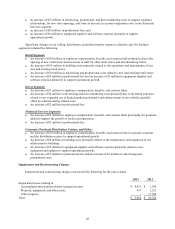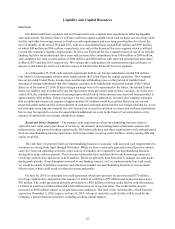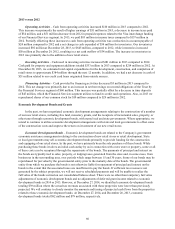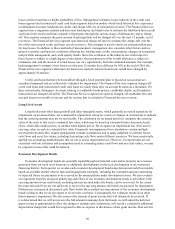Cabela's 2014 Annual Report Download - page 66
Download and view the complete annual report
Please find page 66 of the 2014 Cabela's annual report below. You can navigate through the pages in the report by either clicking on the pages listed below, or by using the keyword search tool below to find specific information within the annual report.56
Our unsecured $775 million revolving credit facility and unsecured senior notes contain certain financial
covenants, including the maintenance of minimum debt coverage, a fixed charge coverage ratio, a leverage ratio,
and a minimum consolidated net worth standard. In the event that we failed to comply with these covenants,
a default would trigger and all principal and outstanding interest would immediately be due and payable. At
December 27, 2014, and December 28, 2013, we were in compliance with all financial covenants under our credit
agreements and unsecured notes. We anticipate that we will continue to be in compliance with all financial
covenants under our credit agreements and unsecured notes through at least the next 12 months.
We have an unsecured $20 million Canadian (“CAD”) revolving credit facility for our operations in Canada.
Borrowings are payable on demand with interest payable monthly. The credit facility permits the issuance of
letters of credit up to $10 million CAD in the aggregate, which reduce the overall credit limit available under the
credit facility.
On February 13, 2014, we announced our intent to repurchase up to 650,000 shares of our outstanding
common stock in open market transactions through February 2015 pursuant to our share repurchase program. We
have not engaged in any stock repurchase activity from the date of this announcement through December 27, 2014.
This share repurchase program does not obligate us to repurchase any outstanding shares of our common stock,
and the program may be limited or terminated at any time. There is no guarantee as to the exact number of shares
that we will repurchase.
Financial Services Segment – The primary cash requirements of the Financial Services segment relate to
the financing of credit card loans. These cash requirements will increase if our credit card originations increase
or if our cardholders’ balances or spending increase. The Financial Services segment sources operating funds
in the ordinary course of business through various financing activities, which include funding obtained from
securitization transactions, obtaining brokered and non-brokered certificates of deposit, borrowings under its
federal funds purchase agreements, and cash generated from operations. During 2014, the Financial Services
segment renewed one of its variable funding facilities for an additional three years and increased the commitment
from $350 million to $500 million, and completed two term securitizations of $300 million and $400 million with
expected principal payment dates in March 2017 and July 2019, respectively. We believe that these liquidity sources
are sufficient to fund the Financial Services segment’s foreseeable cash requirements, including maturities, and
near-term growth plans. Our restricted cash of the Trust totaled $335 million at December 27, 2014, as we repaid
$255 million of Series 2010-I notes in full on January 15, 2015.
WFB is prohibited by regulations from lending money to Cabela’s or other affiliates. WFB is subject to
capital requirements imposed by Nebraska banking law and the Visa U.S.A., Inc. membership rules, and its
ability to pay dividends is also limited by Nebraska and Federal banking law. If there are any disruptions in the
credit markets, the Financial Services segment, like many other financial institutions, may increase its funding
from certificates of deposit which may result in increased competition in the deposits market with fewer funds
available or at unattractive rates. Our ability to issue certificates of deposit is reliant on our current regulatory
capital levels. WFB is classified as a “well-capitalized” bank, the highest category under the regulatory framework
for prompt corrective action. If WFB were to be classified as an “adequately-capitalized” bank, which is the
next level category down from “well-capitalized,” we would be required to obtain a waiver from the FDIC in
order to continue to issue certificates of deposit. We will invest additional capital in the Financial Services
segment, if necessary, in order for WFB to continue to meet the minimum requirements for the “well-capitalized”
classification under the regulatory framework for prompt corrective action. In addition to the non-brokered
certificates of deposit market to fund growth and maturing securitizations, we have access to the brokered
certificates of deposit market through multiple financial institutions for liquidity and funding purposes.
On July 9, 2013, the FDIC adopted interim final rules which revised its risk-based and leverage capital
requirements for FDIC-supervised institutions. These interim final rules are substantially identical to the joint
final rules issued by the Office of the Comptroller of the Currency and the Board of Governors of the Federal
Reserve System on July 2, 2013. The interim final rules and the joint final rules implement the regulatory capital
reforms recommended by the Basel Committee on Banking Supervision in December 2010, commonly referred
to as “Basel III,” and capital reforms required by the Reform Act. Among other things, the interim final rules and
























